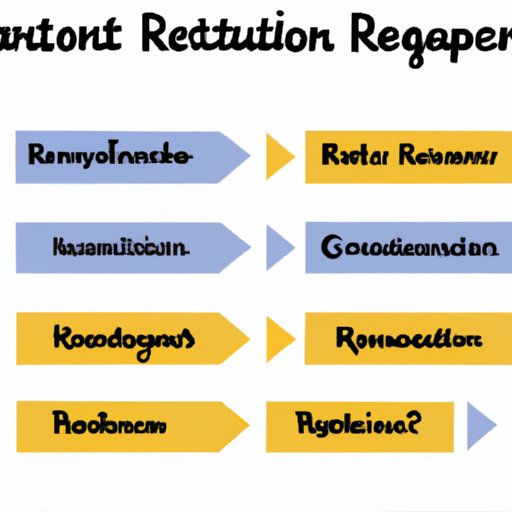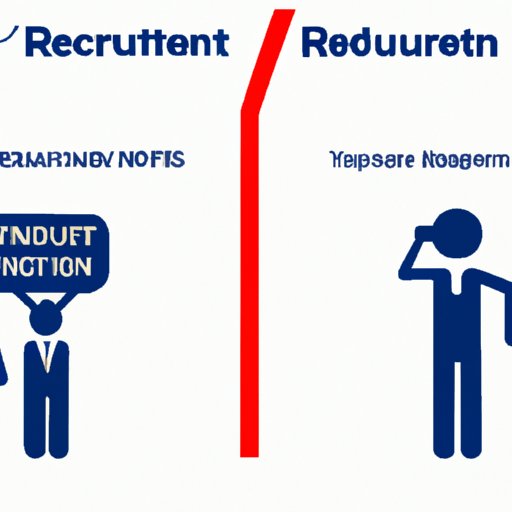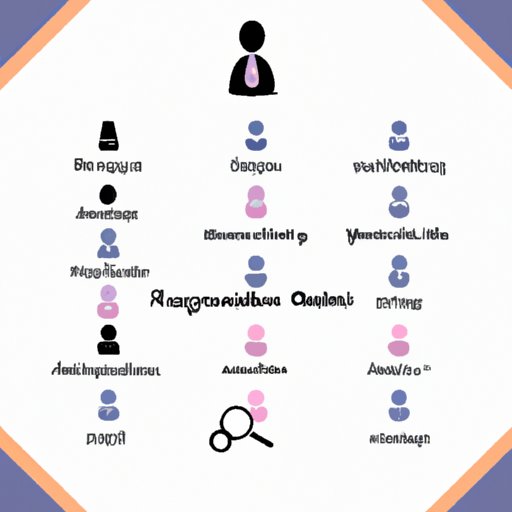Introduction
Recruitment and talent acquisition are two terms that are often used interchangeably in the business world. However, while both processes involve finding and hiring suitable candidates for job openings, there are some important differences between recruitment and talent acquisition.
Understanding the distinction between recruitment and talent acquisition is vital for any organization that wants to hire the best possible candidates for their open positions. This article will explore the differences between recruitment and talent acquisition, compare the roles of recruiting and talent acquisition, and examine the benefits of understanding the difference between the two.

Exploring the Differences between Recruitment and Talent Acquisition
At first glance, it can be difficult to distinguish between recruitment and talent acquisition. Both processes involve searching for, evaluating, and hiring new employees. However, they have different approaches and objectives.
How Recruitment Differs from Talent Acquisition
Recruitment focuses on filling specific job openings with suitable candidates. It involves sourcing, screening, and interviewing job applicants, as well as onboarding new hires. It is typically a short-term process that is completed once the position has been filled.
Talent acquisition, on the other hand, is a longer-term process that focuses on building relationships with potential candidates and developing an effective recruitment strategy. It involves identifying, assessing, and nurturing talent over time, and is designed to create a pool of qualified candidates who can be tapped when needed.
A Guide to Identifying the Difference between Recruitment and Talent Acquisition
To better understand the distinction between recruitment and talent acquisition, consider the following:
- Objectives: Recruitment is focused on filling specific job openings, while talent acquisition is focused on creating a long-term talent pipeline.
- Timeframe: Recruitment is a short-term process, while talent acquisition is a long-term one.
- Strategy: Recruitment is focused on attracting and hiring suitable candidates for specific job openings, while talent acquisition is focused on developing an effective recruitment strategy.
- Outcome: The outcome of recruitment is the successful hiring of a candidate, while the outcome of talent acquisition is a pool of qualified candidates who can be tapped when needed.
Comparing the Roles of Recruiting and Talent Acquisition
Recruiting and talent acquisition both involve finding and hiring suitable candidates for job openings. However, the roles of recruiting and talent acquisition differ significantly.
What You Need to Know About Recruiting vs. Talent Acquisition
Recruiting involves sourcing, screening, and interviewing job applicants, as well as onboarding new hires. It is typically a short-term process that is completed once the position has been filled. Talent acquisition, on the other hand, is a longer-term process that focuses on building relationships with potential candidates and developing an effective recruitment strategy. It involves identifying, assessing, and nurturing talent over time, and is designed to create a pool of qualified candidates who can be tapped when needed.
Examining the Contrasts between Recruitment and Talent Acquisition
The following are some of the key contrasts between recruitment and talent acquisition:
- Goals: Recruitment is focused on filling specific job openings, while talent acquisition is focused on creating a long-term talent pipeline.
- Timeframe: Recruitment is a short-term process, while talent acquisition is a long-term one.
- Focus: Recruitment is focused on attracting and hiring suitable candidates for specific job openings, while talent acquisition is focused on developing an effective recruitment strategy.
- Outcome: The outcome of recruitment is the successful hiring of a candidate, while the outcome of talent acquisition is a pool of qualified candidates who can be tapped when needed.

The Benefits of Understanding the Difference between Recruitment and Talent Acquisition
Understanding the difference between recruitment and talent acquisition can provide many benefits for companies looking to hire the best possible candidates for their open positions.
How Understanding the Difference Can Help Companies Hire the Best Candidates
By understanding the difference between recruitment and talent acquisition, companies can more effectively identify the best candidates for their open positions. By taking a long-term approach to talent acquisition, companies can build relationships with potential candidates and create a pool of qualified candidates who can be tapped when needed.
Improving Efficiency and Streamlining Processes
Understanding the difference between recruitment and talent acquisition can also help companies improve efficiency and streamline their hiring processes. By focusing on creating a long-term talent pipeline, rather than simply filling positions, companies can reduce the amount of time and effort spent on the recruitment process and focus on developing and nurturing long-term relationships with potential candidates.
Conclusion
In conclusion, recruitment and talent acquisition are two processes that are often used interchangeably, but have important differences. Recruitment is focused on filling specific job openings, while talent acquisition is focused on creating a long-term talent pipeline. Understanding the difference between recruitment and talent acquisition can help companies hire the best possible candidates for their open positions, as well as improve efficiency and streamline their hiring processes.
If your company is looking to hire the best possible candidates for their open positions, understanding the difference between recruitment and talent acquisition is essential. Taking a long-term approach to talent acquisition can help you create a pool of qualified candidates who can be tapped when needed, improving efficiency and streamlining processes.
(Note: Is this article not meeting your expectations? Do you have knowledge or insights to share? Unlock new opportunities and expand your reach by joining our authors team. Click Registration to join us and share your expertise with our readers.)
